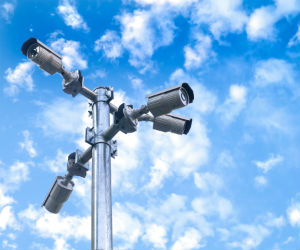The Asian security industry begins 2016 on a high note. Several of its emerging economies are on the right track toward development, there is an increasing awareness among end users about the need for strong security solutions, and there are several new technologies on the horizon that could spearhead demand.
The Asian security industry begins 2016 on a high note. Several of its emerging economies are on the right track toward development, there is an increasing awareness among end users about the need for strong security solutions, and there are several new technologies on the horizon that could spearhead demand.
Market researchers don’t differ in their opinions either. A report from MarketsandMarkets projects the global physical Security Market to grow from US$65.4 billion in 2015 to $105.3 billion by 2020, at a CAGR of 10 percent from 2015 to 2020. Another report from the same research firm places Asia as the main driver behind this growth.
Indeed, India and China, the two largest emerging economies in the region are set to play the key role, although the former is expected to overtake the latter in overall economic growth pace. According to the Organization for Economic Co-operation and Development (OECD), growth in the ASEAN region will be similarly strong, projected to average 4.6 percent in 2015 and 5.2 percent over 2016 to 2020, led by growth in the Philippines and Vietnam. Private consumption will be a large contributor to overall growth, while exports will contribute less than during most of the prior decade.
Expectations High From Solution Providers
 Solution providers expect an increase in
Solution providers expect an increase in
demand in Asian markets in 2016.
Major solution providers have expressed similar sentiments on their expectations from the security market in the region. According to Harish Vellat, GM of Asia Pacific at
Honeywell Fire and Security, Indonesia, Vietnam, and Thailand markets are all expected to perform well in 2016, while several unique reasons could drive demand in other countries.
“Other countries, like the Philippines, have seen a lot of investment going into residential, retail, and hospitality,” Vellat said. “The country is also seeing rapid growth in business process outsourcing industry, putting more demand on grade-A office space.”
He added that his company also expects Myanmar, following its elections this year, to emerge as a promising market in 2016, because the country has generally been lagging behind in infrastructure investment. Myanmar is rich in natural resources, and efforts to tap into this could open up several opportunities for security solutions in the mining sector. Labor intensive industries in the commodity processing sector will also look into Myanmar as the new investment destination.
As countries like Myanmar, Cambodia, and Laos open up their economies to foreign investment, there will be an increased demand for older buildings to be upgraded to compete with newer buildings, Vellat said. This should further boost demand for security solutions in the region.
More Government Funded Projects
 Several Asian governments are expected
Several Asian governments are expected
to make large-scale investments in
security this year.
The year 2015 had seen the concept of the smart city becoming a buzzword in Asia. This year is expected to see more concrete measures in this regard, especially in fast emerging economies like India. Jay Jeong, GM of Sales Team in Americas and Asia at
IDIS hinted at this as he gave his company’s expectations on the year.
“Since Prime Minister Narendra Modi took control of the Indian government, there has been huge investment in infrastructure, which is continuing into next year and beyond, so we expect a very strong year in India,” Jeong said. He added that government-funded construction activities are expected to keep demand for security solutions strong in countries like Singapore and Vietnam too.
The move toward smart cities, which puts further emphasis on urbanization, will be a major factor pushing security demand, according to Vellat. Changing demographics in the region will act as a catalyst for increase in consumer interest.
“For instance rapid urbanization puts more pressure on existing facilities leading to new infrastructure investments,” Vellat said. “People are living further away from the city center and needs to commute, driving the need for more highways and metro or rail networks.”
Major systems integrators too are keeping a close watch on this particular aspect of the market, anticipating major developments to unfold in the coming year. Ferry Chung, VP of Smart and Safe City Center of Excellence of NCS, gave his company’s expectations in the vertical.
“We understand that many major cities in the region have deployed thousands of sensors throughout the cities to monitor noise, humidity, and water level, as well as cameras to monitor public and traffic safety condition,” Chung said. “We look forward to playing a major part in bringing advanced technology to improve the quality of living and security in an urban environment.”
Other analysts are reluctant to talk about the year in itself when it comes to these segments, preferring to comment more on the direction in which the security industry is moving at present. Subhranshu Sekhar Das, VP and Practice Head of Aerospace, Defense, and Security in Greater Asia at Frost & Sullivan, said the major development in the region is the creation of large smarter and safer cities, with security solutions becoming an integral part of building management systems. He too commented on the major efforts being taken in India towards smart cities.
“India has invested large amounts in developing smart cities, and according to the latest news that is coming out, several cities have been selected for this,” Das said.
Jim Simon, Senior Director of Marketing of Asia Pacific at Quantum, elaborated further on this topic, touching upon the major verticals that are expected to see more growth. From the perspective of a storage solutions provider, the company sees an increasing demand that is driven by technological advancements in cameras, regulatory requirements on retention times, and use of analytics.
“Given the surveillance industry transformation, it is no surprise that the top two vertical markets for surveillance storage are airports and city surveillance,” Simon said. “However, there are also tremendous opportunities in education, ports, railways, retail, and casinos, to name just a few.”
The Growth of IT-Based Systems Integrators
 The concept of smart cities is gaining
The concept of smart cities is gaining
popularity in a number of Asian countries.
As end users move from analog systems to IP, systems integration becomes a complex procedure involving digital equipment and their various protocols. Although this has opened up a world of opportunities in this sector, systems integrators (SI) are forced to familiarize themselves with the new systems and keep themselves constantly updated.
While this is the case for traditional security SIs, the new opportunities have brought in installers from a closely related market, IT. Several IT systems integrators have been quick to take advantage of the situation. As more IP-based solutions are expected to enter the market, more IT-based SIs will see benefit.
Frost & Sullivan’s Das agreed to this, noting IT-based SIs will have a more crucial role to play in the security industry in the coming years.
“A lot of solutions integrating systems like biometrics, RFID, access control, etc., are being introduced,” Das said. “This will have an increasing importance for IT companies, especially if they are into software management.”
That said, the broader trend is to incorporate intelligence into the devices. Industry players agree that the year 2016 will see more innovations and adopters in this space.
Internet of Things to Expand Footprint
The recent years have seen strong development in the Internet of Things (IoT) segment, and this is set to continue into the year 2016, supporting the development of the security industry. The key here is to provide more solutions that are mobile, along with higher data quality and functionality.
“Demand for smart applications both for business and security needs are also increasing in smaller installations,” said Magnus Zederfeldt, Regional Director for South Asia Pacific at
Axis Communications. “A key driver here is ease of installation, in smaller systems where both installers and end customers expect plug-and-play solutions with smart capabilities.”
However, being a fairly recent concept, there is still a lot of uncertainty on the true potential of the IoT. In fact, it would be fair to say that what we have seen so far is only a teaser of what the IoT can be. But as more R&D goes into this sector, the year 2016 might become a launch pad for its growth.
A Year of Intelligence and Asian Growth
There is no doubt that the concepts such as IoT and connected devices will receive more prominence in 2016. This, along with government spending plans and increasing security concerns would be the main drivers of growth this year.
The market will continue to remain under pressure from global economic concerns, especially the slowing Chinese economy and the sliding oil prices. There is little doubt that growth in the world’s second largest economy is slowing, but the jury is still out on the extent of the slowdown and its impact on other markets.
But given the nature of the security industry, such concerns may also turn out to be reasons for market growth in the coming year. As the economy tightens, assets become more valuable and securing them becomes vital, along with increasing operational efficiency. Intelligent systems could become more prevalent, and the key focus would be how information can be best utilized for maximum security.
In short, 2016 looks quite promising for the security industry. Last year had seen the rising importance of Asian markets in the global scene, and this year looks just in place to take this forward.